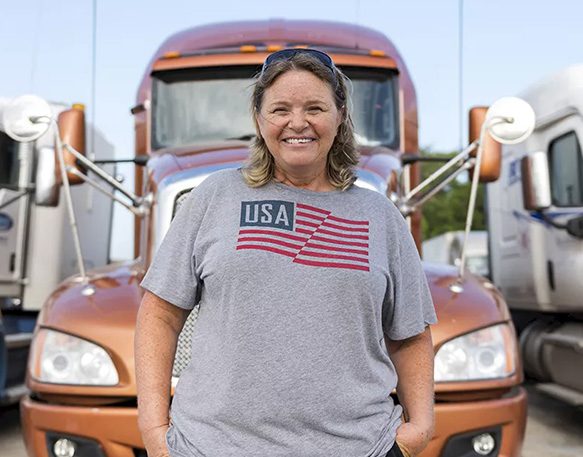When you think of trucking, you probably think of loading cargo, driving it to its final destination, and then unloading it once you get there, but what happens after you deliver a load? After all, the shipment’s final destination probably isn’t yours. Well, there are a few different options.
Sometimes you can pick up another load from the same place and immediately continue on your merry way, whether that means going to a new location or returning to your point of origin with the new cargo in tow. However, if there isn’t another load ready to go — and that’s often the case — you’ll either have to wait around or drive to another location (potentially even all the way home) with an empty trailer. These are called deadhead miles, and it can seriously impact your profitability and safety.
If you’re wondering, “What is deadheading in trucking?” don’t worry. You’re not alone. In this article, we’ll answer questions like:
- What does deadhead mean in trucking, and what are deadhead miles?
- Do drivers get paid for deadhead miles?
- Why is deadhead trucking dangerous?
- How can you minimize or eliminate deadhead trucking?
What does deadhead mean in trucking?
If you don’t already know what deadhead miles are, you need to understand what deadhead means in trucking (and how to avoid it) to stay as safe and profitable as possible when you’re out on the road. Put simply, deadhead miles are the miles that you drive with an empty trailer. However, don’t confuse deadheading with bobtailing, which involves driving without an attached semi-trailer. Both aren’t anywhere near as profitable as hauling a full load, but they’re not the same.
Deadheading might occur when you’re returning an empty cargo container to its point of origin or driving to a new location to pick up another load. Anyone can end up deadheading, but you are far more likely to end up deadhead trucking if you only operate in a specific area. After all, your load options will be more limited due to geography restrictions, so you may have to wait for another load or travel further to pick up one that suits your needs.
Do drivers get paid for deadhead miles?
Unfortunately, most trucking companies won’t pay for deadhead miles. So, despite still being at work on the road, you may end up losing money when deadheading. After all, even if you aren’t carrying any cargo, you’ll still have to pay for fuel to get to your next load, which can add up really quickly.
And that’s not the only cost. You’re also adding wear to your truck with each mile you drive, which can mean increased maintenance costs in the long run and even a trip to the repair shop in the near future. To understand what those expenses look like, imagine this example: In 2018, maintenance and repairs costs were around $0.17 per mile, so deadheading from Buffalo, NY to Rochester, NY to pick up a new load would cost about $12.75 in wear and tear. While it may not seem like much, costs will accumulate over time. For example, if you took that same route five times a week, it would cost you around $3,307 in wear and tear alone each year, not to mention the fuel costs and opportunity cost of deadheading vs. hauling profitable loads.
However, some companies do pay their drivers for deadhead mileage as an incentive, though the pay is relatively minimal. If a company driver is paid for deadheading, they’ll generally receive just $0.60 to $0.90 per mile to cover fuel costs. Owner-operators, on the other hand, will typically have to pay out of pocket for any deadhead miles.
Why is deadheading dangerous?
Deadheading isn’t just costly, it can also be dangerous. Severe weather and deadheading are a dangerous and potentially lethal combination. When winds topped 75 mph in Utah on September 8, 2020, for example, 45 semi-trucks toppled over due to their wide sail area.
The reality is, every time you deadhead, you’re 2.5 times more likely to crash than if you were carrying freight. This is because empty trailers are far more challenging to control — and this is especially true when faced with high winds, black ice, snow, rain, and other weather conditions.
Not only is the weight distribution different, but it will be more difficult to control the rig. Plus, many drivers aren’t paid for deadhead miles, meaning it can be tempting to speed to pick up your next load and start earning money again as soon as possible. All of that means that a single gust of wind that might barely shake a car can result in significant trailer sway, a loss of control, or even a rollover!
To make matters worse, truckers aren’t necessarily trained to deadhead. When you took your truck driving safety training courses and earned your commercial driver’s license, you probably learned how to stay safe on the road and deal with high wind speeds when hauling freight. While those skills are undoubtedly important, driving with an empty trailer in severe weather is an entirely different story and can be dangerous for anyone — even incredibly experienced truckers.
Luckily, there are some precautions you can take to stay safe. You’ll want to secure your doors and any loose items to stay safe when deadhead trucking under severe weather conditions. Before you hit the road, make sure you know your truck’s sail area, and don’t forget to check the weather and wind conditions along your route. Then, once you’re driving, don’t be afraid to slow down to reduce wind force, take the long way around to avoid bridges, or pull over to the side of the road to wait for the weather to improve when necessary. Your safety is more important than getting to your next load as fast as possible. If you hit a patch of black ice, don’t slam on the brakes or yank the wheel, as struggling against black ice can cause you to skid or spin out and completely lose control of your vehicle.
If the physical risks and financial costs aren’t enough to put you off deadhead trucking, remember that deadheading isn’t safe for the environment. Hauling empty trucks releases carbon dioxide emissions without anything to show for it, further contributing to global warming, pollution, and severe weather. In fact, deadhead miles are responsible for around 72 million metric tons of current carbon dioxide emissions! (For comparison, full truckloads produce approximately 205 million metric tons of carbon dioxide emissions.)
How can you minimize or eliminate deadhead trucking?
Deadheading not only causes you to lose time, money, and fuel, but it’s also dangerous, so you want to avoid deadhead trucking whenever possible. The best way to prevent deadhead miles and maximize your fuel, earnings, and time on the road is to use a high-quality load board like DAT.
The DAT load board should be your first stop if you’re trying to locate loads quickly. Not only does the DAT load board connect carriers to quality shippers and brokers from across the country, making it a convenient solution for carriers of any size, but it’s also home to millions of loads, many of which can’t be found anywhere else! So, instead of wasting time, fuel, and money driving around without cargo, you can filter for matches based on your route and quickly find the perfect load for your needs. DAT can help you find available freight along your way and reduce — or entirely eliminate! — deadheading. You can even find cargo on the go using your phone, so if you deliver a load and suddenly realize you need to find a new one or you’ll start deadheading, just whip out your phone and pull up DAT’s mobile app.
Another tip? Practice makes perfect, but so does planning. So, plan your route ahead of time and check for deadhead mileage before accepting a load to limit deadheading while you’re out on the road. Some brokers or shippers include deadhead mileage, but if you don’t see any information, you’ll need to factor in the fuel and maintenance costs you’ll incur by deadheading. You might also consider looking for loads that require return material to help keep your truck weighed down. Luckily, the DAT load board can help you plan routes with high-paying loads and few — if any — deadhead miles, meaning safer, more profitable trips every time.
Cut back on deadhead miles with DAT and our load board
Now that you know what deadhead miles are and all the potential risks of deadhead trucking, answering the question “What is deadheading in trucking?” you know how important it is to pick up loads instead of driving with an empty trailer. Deadhead miles mean increased safety risks, more carbon dioxide emissions, higher fuel and maintenance costs, and a profit loss, so you should do everything possible to avoid deadheading.
The DAT load board is here to help you do just that. With DAT’s load board, the best, largest load board in the industry, you can find loads that suit your needs. Not only does the DAT load board receive 644,500 new loads each day, but it also has an easy-to-use filtering feature that will help you quickly find the best loads for your needs. You can even view brokers’ credit scores to discover who is worth working with and who to avoid.
Also, don’t forget to take advantage of DAT’s other carrier services, such as our freight rate analytics, factoring partners, and fuel cards, to help your business thrive. For example, DAT’s current rates for trucking lanes and nationwide supply and demand maps can help you carefully plan the most profitable route, or you can use one of DAT’s trusted freight factoring partners to improve your company’s cash flow and ensure you don’t have to worry about how to keep the lights on and the truck running while waiting for your broker or shipper to pay you.
Start using the DAT load board and our other carrier services today to cut back on deadhead trucking, reduce stress, and improve profitability!
Avoid deadhead trucking with help from the DAT load board!
Deadhead trucking wastes not only time but also money and fuel. Luckily, the DAT load board makes eliminating deadhead miles — and all the costs and risks that come with them — easy. With DAT, you can quickly find the perfect load, no matter where you’re going.
Start finding loads today!




